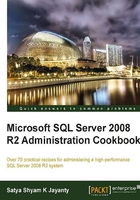
SQL Server 2008 R2 Prologue
The different editions of SQL Server 2008 R2 adapt the unique performance, runtime, and price requirements of organizations and individuals. The SQL Server 2008 R2 data platform meets the need of handling structured data (transactional consistency) and offers relational capabilities to unstructured data by providing a solution that can store and manage many types of data, including XML, e-mail, calendar, media files, documents, geospatial, and many more, which provides a rich set of services to interact with the data and built-in capabilities of search, query, data analysis, processing, reporting, and integration from different data sources. The data accessibility feature is unlimited, whereby it accesses information on creation to archiving on any device, from a global data-center server to desktop or mobile devices.
A new version of SQL Server is related as "Release To Manufacturing" (RTM) version [(Microsoft SQL Server 2008 R2 (RTM)—10.50.1600] that comprises various enhancements as an end-to-end solution area for data platform. The key to the success of any database platform is dependent upon cost-effective and scalable database solutions. SQL Server 2008 R2 helps achieve these goals to deliver an enterprise class data platform to improve efficiency through better resource utilization, and build confidence in end users to scale out the application solutions.
To commence a scalable and high performance database platform design, identifying which SQL Server features are needed is a key aspect of design decision. The SQL Server installation wizard provides a feature tree for installation of various SQL Server components that includes management tools and connectivity components. The different services for SQL Server are independent of each other and run as dedicated services on a system. It is important to know the different services that are running on the core operating system:
- Database Engine: SQL Server and SQL Server Agent are core database engine components that run as services.
- SQL Server service: The Server service is useful for data management. It finds services to store and manipulate data based on the application requirement with a variety of backup and restore solutions. The database engine contains advanced security capabilities to lockdown, protect, and audit the data, in parallel with services to ensure high availability is achieved. For high performance and scalability arrangements, the SQL Server service is accountable to host a relational model service, which facilitates any changes to the data to keep up the transactional consistency to ensure that database will revert to a known consistent state in the event of a server or database failure.
- SQL Server Agent: To automate essential administrative tasks, SQL Server Agent is essential. This service manages the information about scheduled jobs, monitors SQL procedures (performance objects), and processes alerts.
- SQL Server Browser: Browser service works as a listener service to peruse a list of available servers and connects to a correct server instance. SQL Server Browser uses port 1434 to cater to a client request to SQL Server by sending a User Datagram Protocol (UDP) message; the task replies with TCP/IP or named-pipes protocol of installed instances. This is a key service to be used in emergency situations such as connecting to a SQL Server instance using Dedicated Administrator Connection (DAC) endpoints.
- SQL Server Integration Services: Extract, Transform, and Load (ETL) activities are highly manageable and programmable using SQL Server Integration Services (SSIS). This service is capable of performing a variety of tasks to enable packages to import or export data from various file sources, manipulate files in operating system folders, or perform complex calculations inside database tables. A set of specialized tasks such as copy SQL Server objects or perform database backups or database maintenance operations can be designed as out of the box solutions using Visual Studio tools for Applications or the Business Intelligence Development Studio tool.
- SQL Server Reporting Services: To design and manage a flexible platform for reports and data-distribution, SQL Server Reporting Services (SSRS) and tools are available. It creates a standardized methodology and builds complex reports so that the end user can obtain reports rapidly without having any knowledge of programming language or trying to understand the underlying complexity of the RDBMS platform. The SSRS is capable of configuring a report subscription to set up a schedule to execute the report and send it (by e-mail) to the preferred user distribution channel with their prescribed format specifications. The rendering capability to Portable Document Format (PDF) or Excel (XLS) format or Word format (.DOCX) is a highly advantageous feature for a DBA as it takes advantage of two main components—a report server and report designer.
- SQL Server Analysis Services: Decision Support Systems can manage high volumes of data. Blending Business Intelligence features to the system can help us to manage data warehousing issues. The SQL Server Analysis Services (SSAS) is best used to cater the data needs of business users and the ability for IT to manage data efficiently. SQL Server 2008 R2 is built upon highly scalable systems to provide Online Analytical Processing (OLAP) and Data Mining capabilities. The data mart feature with SSAS extends the business analysis to allow the users to find patterns and predictions for their business values by utilizing several built-in mining algorithms.
- Full-Text Search Service: Full-Text Search (FTS) consists of full-text indexing and a search engine, which is integrated into the core database engine. FTS is essential to perform a variety of tasks such as gathering data and sending it to the filter-daemon host for processing to 'tokenize' by a full-text gatherer. Once this is completed, SQL Server receives results to index them as an inverted index structure for optimized performance during a search function.
Built on core SQL Server 2008 technologies, the SQL Server 2008 R2 delivers these enhancements by advancing the efficiency to end users on the areas of high availability, enterprise security, enterprise manageability, data warehousing, reporting, scalability, and performance.